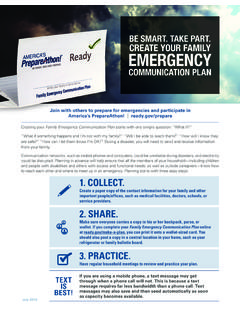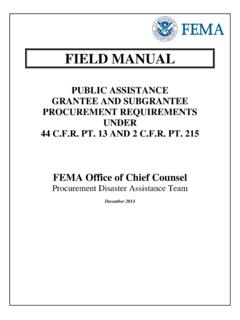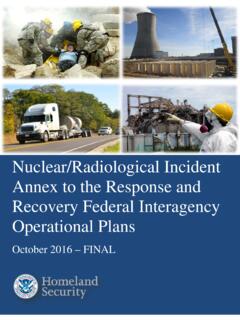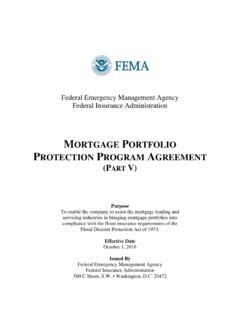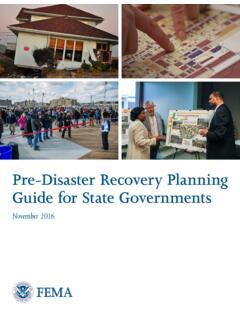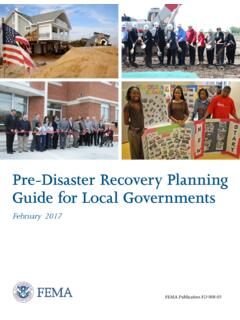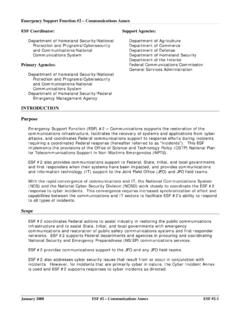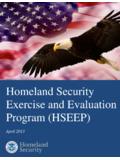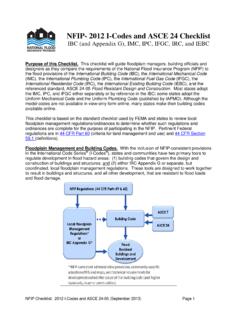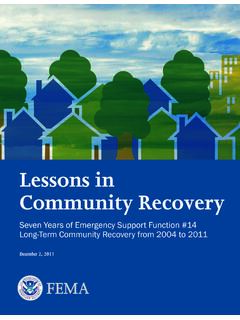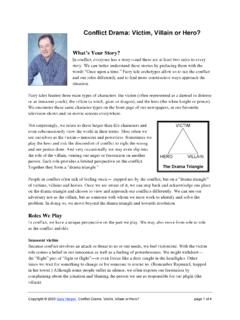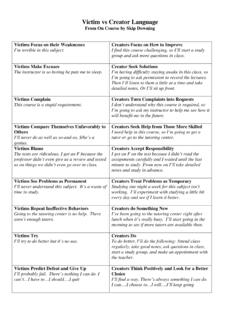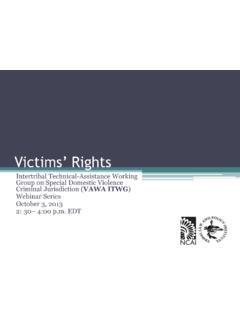Transcription of CERT Drill #3 - FEMA.gov
1 Drill #3 [This page is intentionally left blank] cert DRILLS AND EXERCISES: Drill #3 COMMUNITY EMERGENCY RESPONSE TEAM PAGE i Table of Contents cert Drills and Exercises .. 1 What is a Drill ? .. 1 Exercise 2 For Exercise Staff .. 3 Facilitator Guidelines .. 5 Appendix .. 11 Sample Victim Injury Cards Events and Evaluation Form for Exercise Facilitator(s) and Evaluator(s) Facilitator/Evaluator Feedback Form Participant Feedback Form How to Use This Document This document provides exercise Facilitators with all information and materials needed to plan, conduct, and evaluate an exercise. Do the following: 1. Read through the entire exercise and supporting materials. 2. Decide how to localize the scenario in a way that reflects likely challenges in your community and tests your cert members skills and techniques.
2 3. Familiarize yourself with the flow of the exercise by thoroughly reviewing the Facilitator Guidelines. Use these guidelines to conduct the exercise. 4. Make copies of the supporting documents for participants. See the Appendix index for instructions. 5. Make copies of the Participant Feedback Form and ask participants to complete it after the exercise. 6. Complete the Facilitator/Evaluator Feedback Form after the exercise. [This page is intentionally left blank] cert DRILLS AND EXERCISES: Drill #3 COMMUNITY EMERGENCY RESPONSE TEAM PAGE 1 cert Drills and Exercises The Community Emergency Response Team ( cert ) Program educates ordinary people from all walks of life about disaster preparedness and weapons of mass destruction and trains them in basic disaster response skills, such as fire safety, light search and rescue, and disaster medical operation.
3 Using the training, cert members can assist others in their neighborhood or workplace following an event and can take a more active role in preparing their community. The National cert Program has developed a library of drills and exercises. These exercises have been designed in a ready-for-use format and include complete instructions, detailed lists of materials, and all supporting forms. This document is used by the Facilitator(s) and supports the delivery of a Drill that can be customized to meet local needs. What is a Drill ? Drills are supervised activities that provide the opportunity for cert members to validate a specific operation or function, usually focused on one or two key skills, such as splinting and bandaging or lifting and cribbing. Drills can also be used to determine if plans can be executed as designed, to assess whether more training is required, or to reinforce best practices.
4 A Drill is useful as a stand-alone tool. Participants engage in the activity, which may or may not be based on a scenario. Facilitators and Evaluators observe the participants as they practice the skills and techniques, but generally hold feedback until the end of the activity unless an action is unsafe. Participant learning is reinforced and feedback is provided through a hot wash at the conclusion of the Drill . For descriptions and other types of exercises for CERTs, please visit and click on cert Exercises. cert DRILLS AND EXERCISES: Drill #3 PAGE 2 COMMUNITY EMERGENCY RESPONSE TEAM Exercise Overview Drill #3 Hazard: Multi-vehicle car crash Location: Local road Duration: 1-2 hours Capabilities Exercised: Medical triage Lifesaving interventions Splinting and bandaging Documentation Sizeup Exercise Objectives: Evaluate the process for assessing and prioritizing victim conditions.
5 Assess the procedures for opening airways, controlling bleeding, and treating for shock. Evaluate procedures for applying splints and bandages. Evaluate methods for documenting actions taken Validate cert sizeup procedures. Scenario: A careless camper accidentally started a small brush fire at 3 By 7 , smoke from the brush fire had spread along the local highway. Morning fog mixes with the smoke to create very low visibility. A large truck slows quickly and is hit from behind by a car. Poor visibility causes a collision involving several other vehicles. There are multiple injuries reported. The Fire Department is busy fighting the brush fire and has asked the local team to respond to the accident and assess victim injuries. The Fire Department expects to be on scene within 30 minutes.
6 cert DRILLS AND EXERCISES: Drill #3 COMMUNITY EMERGENCY RESPONSE TEAM PAGE 3 For Exercise Staff Exercise Synopsis: This Drill gives participants the opportunity to triage a number of victims , practice applying splints and bandages, and perform head-to-toe assessments. Moulage can be used to enhance realism, and the degree of difficulty can be increased by varying the individual victim injuries. This Drill can be performed with volunteer victims , or simulated victims like gingerbread cutouts. Since this Drill focuses on medical procedures and not search and rescue, the victims will be placed on the ground and readily accessible for triage. For the purposes of this Drill , they do not need to be relocated to the medical area. Exercise Materials and Staff: Facilitator (1) Exercise Evaluator(s) to follow and observe each team for proper technique and safety Volunteers and/or simulated victims Moulage for volunteer victims (optional) Materials for splinting and bandaging Forms: o Sample Victim Injury Cards, used to set up the exercise o Events and Evaluation Form For Exercise Facilitator(s) and Evaluator(s), used by the Facilitator(s) and Evaluator(s) during the exercise o Facilitator/Evaluator Feedback Form, completed after the exercise o Participant Feedback Form, completed after the exercise Exercise Staff Roles: 1.
7 Facilitator The Facilitator will play three roles during the Drill . First, the Facilitator will lead and guide the Drill by presenting the scenario and instructions. Second, the Facilitator will observe and coach. In this role, he or she will observe the group process. As the Drill unfolds, the Facilitator will watch for potential safety issues. He or she may also need to help the team members clarify their decision making by asking questions about their thought process and the factors they considered in making choices. For example, if they placed a high priority on helping a victim who was probably dying, or if they decided to enter a building that was clearly too dangerous, work through their decision-making process so they realize the potential negative cert DRILLS AND EXERCISES: Drill #3 PAGE 4 COMMUNITY EMERGENCY RESPONSE TEAM results of their decision.
8 Depending on circumstances, it may be better to wait until the Drill is concluded to begin this discussion. Third, the Facilitator will conduct a hot wash (debrief).The purpose of the hot wash is to reinforce learning by helping participants evaluate their own decision making. It is a balance between: Asking participants why they made the choices they did and what they learned. Providing additional information and coaching. Bear in mind that, although the Facilitator may have more experience and knowledge, participants will likely learn more if coached through their decision-making process than if they are told what they should have done. During the hot wash and after the exercise, the Facilitator has additional responsibilities including collecting feedback on the exercise and how beneficial it was for cert participants, and providing input to improve future cert exercises.
9 2. Evaluator The role of Evaluator is sometimes assumed by the Facilitator if staff resources are limited. The primary responsibility of the Evaluator is to assess the exercise based on the events and expected actions listed on the Events and Evaluation Form For Exercise Facilitator(s) and Evaluator(s). The Evaluator typically has a passive role and does not interfere with the Drill unless he or she is also playing the role of Facilitator. 3. Safety Officer Every team should have a Safety Officer responsible for monitoring safety of all participants. The Evaluator may serve as the Safety Officer but only if there is a Facilitator assigned to the team, , every team should have two staff assigned to it. cert DRILLS AND EXERCISES: Drill #3 COMMUNITY EMERGENCY RESPONSE TEAM PAGE 5 Facilitator Guidelines Step Action What to Say/Do 1 Set up the Drill .
10 Make copies of the handouts in the Appendix. The Appendix index indicates how many copies are needed. Assign injury cards to the victims . Suggested injury cards are located in the Appendix. Brief exercise staff and victims on their role as appropriate. Apply victim moulage if appropriate. If volunteers are not available, affix victim descriptions to cutouts or other victim replacements. 2 Introduce the exercise to all participants. Distribute the one-page Exercise Overview to all participants. Explain that the purpose of the exercise is: To provide an opportunity to practice specific skills in a realistic simulated environment. To improve cert s operational performance by practicing and validating policies, plans, procedures, and training in the risk-free environment of an exercise.
